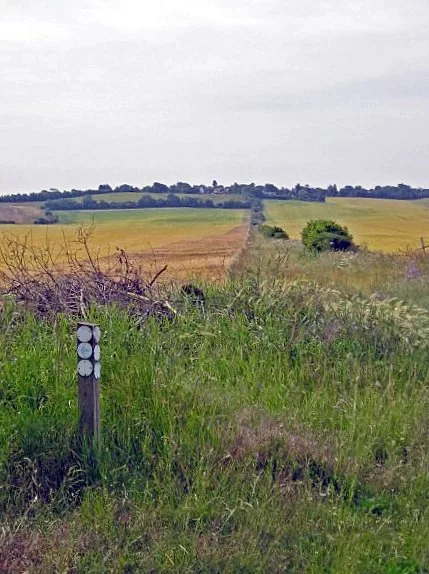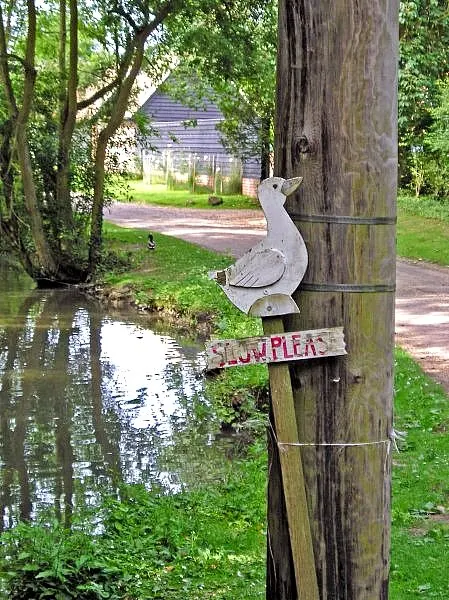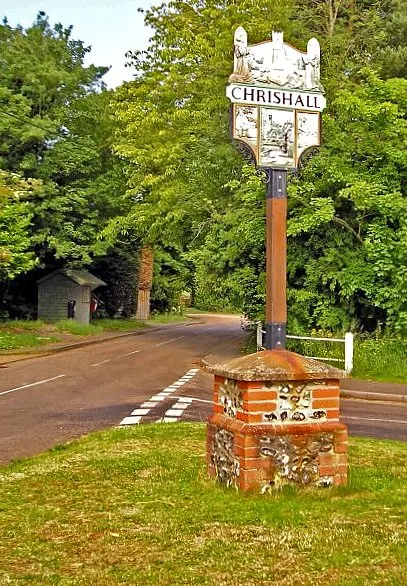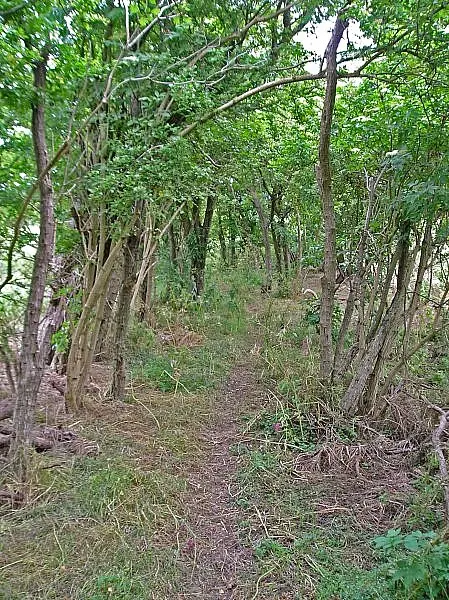The Icknield Way - Fowlmere to Linton

A 16 mile walk along the Icknield Way between Fowlmere and Hinton
The path keeps to the ridge along the hills, though the land now flattens out as it heads eastwards. There are picturesque villages and hamlets as the route winds its way through some traditional old English countryside.

Walk Statistics
Maps
The following maps and services can assist in navigating this route. There are links to printed maps and links to downloadable GPX route data for importing into navigational software and apps.
- Ordnance Survey Explorer Map
- OS Explorer 209 - Cambridge
- GPX Route File
Accommodation
Crown Inn, LintonB&BView in OS Map | View in Google Map
- Website
- http://www.crownatlinton.co.uk/
- Description
- Bed and Breakfast at the Crown Inn, Linton
Walk Notes
The previous evening I had taken an excursion off route to find a place to pitch at a small campsite at Fowlmere. This provided a cheap pitches for hikers and was in close proximity to the village where there was the usual amenities for food and drinks. For this days walk I had managed to find a bed and breakfast accommodation at The Crown Inn in the Cambridgeshire village of Linton, some 16 miles ahead which gave ample time to cover the distance and to enjoy the walk. This was somewhat heartening as I had covered some 60 miles in three days and it was a welcome relief to have a few miles less to cover.
The previous evening an old friend had joined me at camp, bringing along a few bottles of ale. There was one left. Marstons Old Empire, a well hopped IPA. At 5.7% this was not to be tangled with and with due consideration it was something to celebrate at the end of the days walk. But then the thought of carrying extra weight in my bag for a day gave second consideration. One always needs to reduce weight as much as possible when hiking with a full kit and having bottles of beer was taking the idea of necessities a bit too far. There was only one thing for it. Breakfast beer. The bottle was opened, the rich nectar plundered and the camp de-pitched to saunter off with a sprightly spring in my step!
The walk started with a stroll down the lane onto the main road from where there is a short walk along another lane down to the Icknield Way trail. Now, this was early morning, sometime around 7.30-8am and the A505 trunk road was heaving. A mass of traffic in both directions. Commuters going between Royston and Cambridge. Never ending lines of traffic with one person in each car. The freedom of the highway. Staring up someone else's exhaust. It took more than several minutes to cross this monstrosity. Waiting for a moment when there was a break in traffic travelling in both directions then taking ones life in ones hands to sprint across. It was a relief to hanker away from that turgid road, back to the solitude of open countryside.
The Icknield Way was rejoined at Heydons Ditch which is assumed to be a Saxon earthwork that was probably dug out for defence purposes. It leads up the hill to the village of Heydon, climbing some 90m over 1.5 miles. Once past the modern brick houses at the start of the village, one passes typical English thatched cottages, then there is a triangular green with a bench on it with the village church opposite. A place to sit and take it all in for a few minutes before continuing the journey. This was to set the theme for the day, with the numerous Stereotypical English villages that adorn the hills along this part of the trail. When I say hills, this is nothing like the Cotswolds this is just higher ground.
Next village is Chrishall with its duckponds and then Elmdon which once boasted a Norman castle although all that exists now is a mound. The its on to Strethall. Each village is connected with paths through cultivated fields. This really is rural England in all its glory.
Beyond Strethall the path descends down the hills to cross the M11 motorway. This is a along a straight track across the fields that leads into Great Chesterford. It runs along the course of an old Roman Road and has large hedges, somewhat overgrown either side of the narrow footpath.The going became difficult, with thoughts of battling out through one hedge and walking the field-side. I persevered, blindly pushing forward through the undergrowth and the overhanging branches. A rabbit hole caught me out and left me stumbling with a twisted ankle. Thankfully no serious damage was sustained from this mishap.
A footbridge traverses the motorway and drops down onto a road which runs alongside the railway to a crossing. The crossing is one of the modern automated barrier kind and the lights were flashing and the gates down. Alongside this, down in a gulley is an alternative route under a bridge. But for any avid train spotter the crossing is worth standing at. As did a car. It must have been driven by a train spotter. We waited. And waited. Straining ears to listen to an approaching locomotive. But nothing. It must have been five minutes at least if not more when the barriers started to move upwards having no visible train pass. But before they lifted to the full extent, the descended back down and we had to wait for another invisible train. These new classes of invisible train reserve a particular disdain among the train spotter fraternity as not only can they not be seen but the object of collecting their number is even even more of a challenge. When the barriers finally lifted I had witnessed two invisible trains and had not a clue what numbers they were. I shall underline them on the blank page at the back of the locospotters book, obviously a page dedicated to invisible engines.
The route passes the Crown and Thistle pub in Great Chesterford. A welcome break before the last section to Linton where the benches outside allowed me to remove my boots and put my feet up without shocking a customer base with aromas of sweaty soles. An hour was spent here slowly supping on a pint and watching life go by without a care in the world. Eventually one has to get back to the purpose in hand, re-lace the boots, strap on the gear, deposit the glass in the pub and head off, back up the hills. As stated previously, these are not obvious hills, but one still climbs to 114m on this stretch of the walk and from the highest point on Great Chesterford Common one can gaze down to Linton in the valley beyond. The Icknield Way is an ancient track and the obvious choice would be to follow the ridges of hills which would be less susceptible to boggy and marshy conditions.
Directions
From Fowlmere take the Chrishall Road down to the A505. Turn right and follow the A505 for a few hundred yards where a minor road on the left takes you back down to the Icknield Way. the ancient Icknield Way crosses this road at Three corner Plantation but the modern route is found by taking the track on the right for 300yds where the route takes the Heydon Ditch on the left. From here follow the waymarkers through Heydon, Chrishall, Elmdon and Strethall. The path now heads northwards where it joins a former Roman road from Braughing and Great Chesterford which is now just a path between two hedgerows which are pretty overgrown and can be a challenge to get along. Eventually this path crosses the M11 and enters Great Chesterford. Paths across fields lead the remaining distance through to Linton.
Pubs
Crown and Thistle, Great Chesterford View in OS Map | View in Google Map
- Address
- Crown and Thistle, Great Chesterford
- Website
- https://www.thecrownandthistle.pub/
A traditional pub dating from the 16th century when it was a coaching inn. The pub is renowned for its food. Guest ales.
There are two wooden benches on the side of the road in front of the pub which are good for walkers to rest their feet and watch the world go by. They had two ales on offer, Adnams Bitter and Fullers London Pride. The Pride was very satisfying.
The Crown Inn, Linton View in OS Map | View in Google Map
- Address
- The Crown Inn, Linton
- Website
- crownatlinton.co.uk/
Large building offering B&B, in a self contained block at the rear of the building. A brasserie-style restaurant offers a variety of food including daily specials which features fresh fish and meat dishes sourced from local suppliers. Guest ales on offer.
There was a distinct lack of staff when I turned up at 4pm. As I waited on the benches at the side of the pub one resident declared that he was fed up with the lack of service and was collecting his belongings to transfer to another pub further up the road. No complaints about the beer and food though. I stuck with Woodfordes Wherry throughout the evening, a personal favourite at the time. It was young, fresh and full of hops as it should be.
Features
Heydon DitchView in OS Map | View in Google Map
The Heydon Ditch is a large earthwork that runs in a straight line from Heydon to Fowlmere. It would have consisted of an earth bank and ditch but most of this has now been lost to agriculture. The present day Icknield Way follows its course from close to the A505 down into Heydon. The ditch is said to date from Saxon times and was built as either defences or enclosures. Local legend dating back hundreds of years states that it is haunted by the ghosts of giant warriors, and headless Saxon skeletons were uncovered during excavations in the 1950s.
ChrishallView in OS Map | View in Google Map
The village of Chrishall was listed in the Domesday Book as Cristeshalla, or "nook of land dedicated to Christ" which is one of only two English settlements whose name contains the word "Christ". At 482ft above sea level, the village is the highest point in Essex. Following the Norman Conquest the area around Chrishall was given to Eustace of Boulogne who built and occupied a house on a hill to the south of the current church. He named the house "Flanders" and it was there that his daughter Matilda of Boulogne, later wife of King Stephen was raised. The house survived until the 15th century, and is believed to have stood on the site of Chiswick Hall, itself built in the 17th century by Sir John James. The church of The Holy Trinity dates from the 12th Century and is Grade I Listed Building.
ElmdonView in OS Map | View in Google Map
Along with Strethall and Chrishall, Elmdon is one of the Essex ridge villages which remained isolated since the main roads passed them by. Until the 19th century its chief industry was woolcombing and weaving worsteds and fustians. Today Elmdon is a commuter village at the meeting of three roads. This central point consists of a small triangular green, where the war memorial is sited and surrounded by many picturesque cottages.
StrethallView in OS Map | View in Google Map
The name of Stretshall means 'nook' or 'sheltered corner' on the 'street' – a reference to the Roman road which ran through here from Braughing to Great Chesterford, following the line of an even more ancient trackway. Whilst the present day village can only be approached up two dead-end roads, it was once a major communication route in this part of the world. Local legend tells of a story during the civil war where three Royalist brothers named Richards were besieged in the manor house by Parliamentary troops from the camp on Thriplow Heath. The brothers escaped, having held off the Roundheads for a day and a night. Another legend tells of the shooting of a gypsy by a farmer named Nehemiah Perry in 1849. Perry lived in the manor house into which the gypsy accompanied by two others had broken into. Perry caught them on the staircase and shot Abraham Green dead. At the inquest a verdict of Justifiable Homicide was recorded and Perry was congratulated on his courage. The corpse was initially displayed in the Church tower for a few days for identification which enabled an enterprising sexton to charge 3d to would-be viewers. After no-one claimed the body, Perry despatched it in a game hamper to his medical adviser, Dr George Paget, at the Cambridge University Anatomy School. To this day, the skull of Abraham Green can still be seen in the Duckworth Collection of the Department of Biological Anthropology while about half of his bones are kept in the Museum of Zoology.
Great ChesterfordView in OS Map | View in Google Map
The ancient village of Great Chesterford sits on the banks of the River Cam. It has been inhabited by Bronze Age followed by the Romans who erected many buildings including a tax office and a temple and alos built a wall around the town. The church of All Saints dates from the 13th century, and has had many additions over the years. Local legend tells of the silver bells which hung in the church tower and were hidden in an underground passageway which ran between the Church, the Old Vicarage and the Crown House Hotel to keep them safe from government soldiers. They have never been found, although some traces of the passageway have been uncovered.
Links and Bibliography:
Image Gallery




Route Validation Cards
Validation Date - 2009-06-21
- Time of Walk: 08:00 to 15:00
- Validators: Griffmonster
- Weather Conditions: Light grey skies with occasional sun and warm
- Notes: Initial route undertaken
Summary of Document Changes
Last Updated: 2026-01-12
- 2010-12-15 : Initial publication
- 2016-11-05 : General website updated
- 2019-01-20 : General website updates and rewrite of notes
- 2021-03-17 : Update website improvements and removal of ViewRanger reliance
- 2021-12-01 : Removal of ViewRanger links due to its imminent demise






0 comments:
Post a Comment